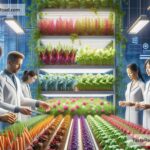The Future of Food and Renewable Energy: A Bright and Sustainable Path
The way we grow food and produce energy is changing fast. With new technologies and ideas, the future looks exciting—but also challenging. Renewable energy and sustainable food production are becoming key to ensuring a healthy planet and a good quality of life for everyone. Let’s explore what the future holds in these areas, using simple language.
The Future of Food: Feeding a Growing Population
Today, there are over 8 billion people in the world, and this number is expected to grow even more in the coming decades. Feeding everyone is a big challenge. Farmers face issues like climate change, limited farmland, and water shortages. But the future of food offers some exciting solutions.
1. Vertical Farming and Urban Agriculture
Have you ever considered growing food in tall buildings instead of big fields? That’s what vertical farming is all about. In the future, we may see farms inside skyscrapers, complete with LED lights that help plants grow, even without natural sunlight. This method uses less water and no pesticides, making food production cleaner and greener. Urban agriculture, where people grow food in cities—on rooftops or in community gardens—will also become more popular. These innovations will provide fresh food close to where people live.
2. Lab-Grown Meat
Meat is a big part of many people’s diets, but raising animals uses a lot of land, water, and energy. Scientists have found a way to grow meat in labs, without needing real animals. Lab-grown meat, also called cultured meat, requires fewer resources and could reduce greenhouse gas emissions. In the future, this could be an affordable and environmentally friendly way to enjoy burgers and steaks.
3. Alternative Proteins
Besides lab-grown meat, there are other protein sources that will become more common in the future. For example, insects like crickets and mealworms are packed with nutrients and require very little land and water to raise. Plant-based proteins, like those made from peas or soybeans, are already gaining popularity thanks to brands creating tasty alternatives to traditional meat.
4. Smarter Farming with Technology
Farmers are already using technology to grow food more efficiently, and this trend will only grow. Drones and robots can help monitor crops, distribute seeds, and harvest produce. Data from satellites and sensors allows farmers to predict weather changes and water crops at just the right time. This tech saves resources, boosts production, and ensures less food waste.
The Future of Renewable Energy: Clean Power for Everyone
Energy powers everything we do, from driving cars to cooking meals. But using fossil fuels like coal, oil, and gas harms the planet by releasing greenhouse gases that cause global warming. The future of renewable energy will focus on cleaner ways to generate power while protecting the environment.
1. Solar and Wind Power
Solar panels and wind turbines are becoming more advanced and affordable. Solar energy comes from sunlight, and wind energy comes from the wind—both are renewable resources, meaning they won’t run out. New inventions aim to make solar panels more efficient and usable even on cloudy days. Wind turbines, especially offshore ones, are becoming bigger and better at harnessing the power of the wind.
2. Energy Storage
One challenge with renewable energy is that it depends on nature. For example, solar panels don’t work at night, and wind turbines stop spinning when there’s no wind. That’s where energy storage comes in. Batteries are being designed to store extra energy when it’s sunny or windy, so we can use it later. In the future, super-efficient battery systems will help make renewable energy a reliable choice.
3. Green Hydrogen
Hydrogen is the most abundant element in the universe, but it is challenging to use as a fuel. Scientists are exploring ways to produce “green hydrogen,” which is created using renewable energy instead of fossil fuels. Green hydrogen could power vehicles, factories, and even entire cities without polluting the environment.
4. Smart Energy Systems
The future of renewable energy also includes smarter ways to manage power. Imagine homes, businesses, and cars that can all talk to each other using advanced systems to share energy efficiently. Smart grids will transfer energy from one place to another based on demand, reducing waste and ensuring people always have the power they need.
Challenges and Opportunities
Transitioning to sustainable food systems and renewable energy won’t be easy. These innovations require big investments, education, and global cooperation. Some technologies are still expensive, and governments and companies need to work together to make them affordable for everyone.
However, the opportunities are endless. By embracing better ways to grow food and produce energy, we can fight climate change, reduce pollution, and ensure a healthier future for generations to come. People everywhere will have access to clean energy and nutritious food, improving lives and lifting communities out of poverty.
Conclusion: A Sustainable Future for All
The future of food and renewable energy is full of promise. Vertical farms, lab-grown meat, solar panels, and green hydrogen are just a few examples of how innovation is paving the way for sustainability. These advancements not only help the environment but also create jobs, improve health, and enhance the way we live.
Each of us has a role to play in supporting this transition. Whether it’s choosing plant-based meals, installing solar panels, or advocating for greener policies, small actions can make a big difference. Together, we can build a world where both food and energy are clean, efficient, and abundant—for everyone, everywhere.


